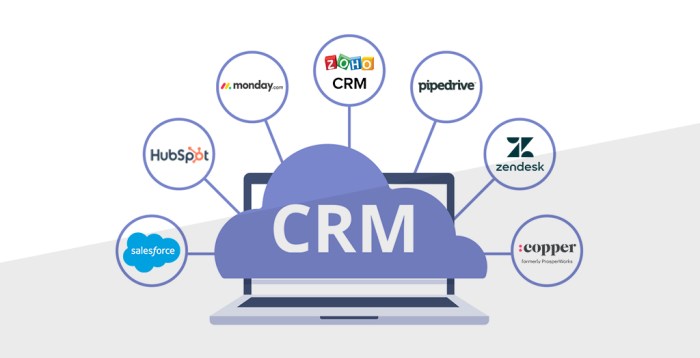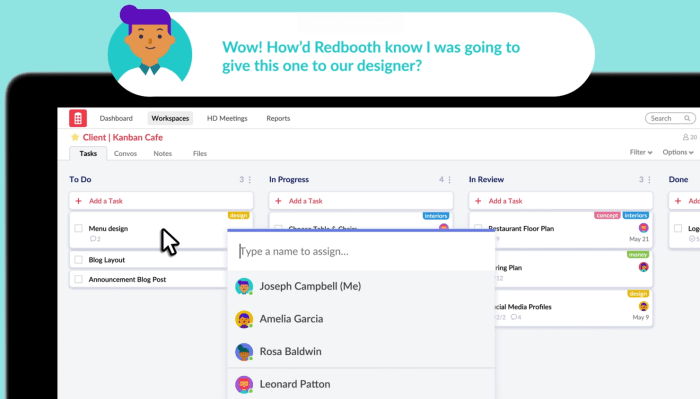Best CRM software for remote teams is crucial for maintaining productivity and collaboration in today’s increasingly distributed workforce. Effective communication, streamlined workflows, and secure data management are paramount for remote teams, and the right CRM system can significantly enhance these aspects. This exploration delves into the essential features, selection criteria, and implementation considerations for choosing the ideal CRM solution to support remote team success.
We’ll examine how CRMs address common communication challenges, compare on-premise and cloud-based options, and highlight the importance of seamless integration with other business tools. Furthermore, we’ll explore cost implications, data migration strategies, and best practices for training remote teams on a new CRM system, ensuring a smooth transition and maximizing its benefits.
Defining Needs of Remote Teams
Effective CRM implementation for remote teams hinges on understanding their unique communication challenges and workflow requirements. Addressing these needs directly translates to improved productivity, collaboration, and overall team success.
Communication Challenges and CRM Mitigation
Three prominent communication challenges faced by remote teams are inconsistent information access, delayed responses, and difficulty in tracking progress on shared tasks. A CRM system directly addresses these issues. Centralized data storage within a CRM ensures everyone accesses the same, up-to-date information. Automated notifications and task assignments expedite responses and reduce delays. Progress tracking features offer real-time visibility into project status, fostering better collaboration and accountability.
Key CRM Features for Remote Team Workflows
A CRM tailored for remote teams needs specific features to streamline workflows. These include robust contact management, task and project management capabilities, seamless communication integration, and detailed reporting and analytics. These features collectively facilitate better organization, communication, and overall team efficiency.
On-Premise vs. Cloud-Based CRM Solutions

| Feature | On-Premise | Cloud-Based | Advantages/Disadvantages |
|---|---|---|---|
| Cost | High initial investment, lower ongoing costs | Lower initial investment, recurring subscription fees | On-premise offers potentially lower long-term cost if usage remains high. Cloud-based offers flexibility and scalability, but costs can increase with usage. |
| Security | Greater control over data security, but requires dedicated IT resources | Security managed by the provider, potentially less control but often robust security measures | On-premise requires significant investment in security infrastructure. Cloud-based providers generally offer strong security, but reliance on third-party security is a factor. |
| Accessibility | Limited to internal network access | Accessible from anywhere with internet access | On-premise limits accessibility. Cloud-based offers anytime, anywhere access, improving remote team collaboration. |
| Scalability | Scaling requires significant investment in hardware and software | Easily scalable based on subscription level | On-premise scaling is costly and complex. Cloud-based solutions offer seamless scalability to meet growing needs. |
Top CRM Features for Remote Collaboration
Several essential CRM features significantly boost remote team productivity and collaboration. These features enhance communication, task management, and overall team efficiency.
Essential CRM Features for Remote Productivity
- Centralized Contact Database: Provides a single source of truth for all customer and prospect information, eliminating information silos and improving data consistency across the remote team.
- Integrated Communication Tools: Facilitates direct communication within the CRM, eliminating the need to switch between multiple platforms. Examples include built-in chat, email integration, and call logging.
- Task and Workflow Automation: Automates repetitive tasks, such as lead assignment, follow-up emails, and reporting, freeing up time for more strategic activities.
- Real-time Data Synchronization: Ensures that all team members have access to the same up-to-date information, regardless of their location. This eliminates data discrepancies and improves decision-making.
- Customizable Dashboards and Reporting: Provides team members with a clear view of key performance indicators (KPIs), allowing them to track progress and identify areas for improvement.
Integrated vs. Standalone Project Management Tools, Best CRM software for remote teams
Integrating project management tools within a CRM streamlines workflows by centralizing all project-related information within a single platform. Standalone tools offer specialized features but can lead to data silos and require switching between platforms. The choice depends on team size, complexity of projects, and budget.
Real-time Data Synchronization for Seamless Collaboration
Real-time data synchronization ensures all team members work with the most current information. This eliminates confusion, prevents duplicated efforts, and fosters a more cohesive and efficient workflow. For example, if a sales representative updates a customer’s contact information in the CRM, that update is immediately reflected for other team members, regardless of location.
CRM Software Selection Criteria: Best CRM Software For Remote Teams
Choosing the right CRM requires careful consideration of various factors, including scalability, security, and user-friendliness. A thorough evaluation process ensures a successful implementation and maximizes the benefits for the remote team.
Checklist for Evaluating CRM Software

Remote teams should prioritize CRM software that meets their specific needs. Key factors include scalability to accommodate growth, robust security features to protect sensitive data, and an intuitive user interface to ensure easy adoption and usage.
- Scalability: Can the system handle increasing data volume and user numbers?
- Security: Does the system offer robust data encryption, access controls, and audit trails?
- Ease of Use: Is the system intuitive and easy to navigate, even for users with limited technical skills?
- Integration Capabilities: Does the system integrate with other essential business tools?
- Cost-Effectiveness: Does the pricing model align with the budget and projected usage?
Importance of User-Friendly Interfaces
An intuitive interface is crucial for remote team adoption. A user-friendly CRM reduces training time, minimizes frustration, and encourages consistent usage, leading to better data quality and improved team productivity.
Essential Security Features for Remote Teams
- Data Encryption: Protects data in transit and at rest.
- Access Controls: Restricts access to sensitive data based on user roles and permissions.
- Two-Factor Authentication: Adds an extra layer of security to prevent unauthorized access.
- Regular Backups: Ensures data recovery in case of system failure or data loss.
- Audit Trails: Tracks user activity, allowing for monitoring and detection of suspicious behavior.
Integration with Other Tools
Seamless integration with other business tools significantly enhances the value of a CRM for remote teams. This integration streamlines workflows, improves communication, and provides a holistic view of business operations.
CRM Integration with Communication Platforms
Integrating a CRM with platforms like Slack or Microsoft Teams allows for direct communication within the CRM context. For instance, a sales representative can directly message a colleague about a customer issue without leaving the CRM interface.
Integration with Other Business Tools
Integrating a CRM with marketing automation tools automates marketing tasks, such as email campaigns and lead nurturing. Integration with sales analytics tools provides valuable insights into sales performance, enabling data-driven decision-making. These integrations improve efficiency and provide a comprehensive view of business processes.
Advantages of Automated Workflows
Automated workflows streamline repetitive tasks, freeing up time for more strategic work. For example, automated lead assignment ensures that leads are promptly routed to the appropriate sales representative, while automated email sequences nurture leads and improve conversion rates. This reduces manual effort and increases overall efficiency.
Cost and Implementation Considerations
Implementing a new CRM system requires careful planning and execution. Understanding the cost implications and potential challenges ensures a smooth transition and successful adoption by the remote team.
CRM Pricing Models
CRM solutions offer various pricing models, including subscription-based plans (e.g., monthly or annual fees), one-time purchases, and tiered pricing based on features and user numbers. Choosing the right model depends on the team’s size, budget, and anticipated usage.
Implementing a New CRM System
Implementing a new CRM involves several steps: needs assessment, software selection, data migration, user training, and ongoing support. Potential challenges include data migration issues, user resistance to change, and integration complexities. Addressing these challenges proactively ensures a smooth transition.
Data Migration Process
Migrating data from an existing system to a new CRM requires careful planning to ensure data integrity and security. This process often involves data cleansing, transformation, and validation to ensure accurate and consistent data in the new system. Data security measures, such as encryption and access controls, should be implemented throughout the migration process.
Case Studies of Successful CRM Implementations
Several companies have successfully leveraged CRM systems to enhance remote team productivity and collaboration. These examples demonstrate the positive impact of a well-implemented CRM on remote team performance.
Successful CRM Implementation Examples

- Company A: A marketing agency that transitioned to a cloud-based CRM to improve lead management and client communication. They faced challenges with inconsistent information access and communication delays. The CRM solution centralized data, automated workflows, and improved communication, resulting in a 20% increase in lead conversion rates.
- Company B: A software development company that implemented a CRM to track project progress and improve team collaboration. They faced challenges with project delays and inefficient communication. The CRM’s project management features and real-time data synchronization improved project visibility and team coordination, leading to a 15% reduction in project completion time.
- Company C: A sales team that adopted a CRM to streamline sales processes and improve customer relationship management. They struggled with inconsistent sales data and difficulty in tracking customer interactions. The CRM’s centralized database and reporting features improved data accuracy and sales performance, resulting in a 10% increase in sales revenue.
Example CRM Dashboard
A sample dashboard might include metrics like: Total deals closed this month (bar chart), average deal size (line graph), number of new leads generated (pie chart), customer satisfaction score (gauge chart), and average response time to customer inquiries (line graph). Each metric provides valuable insights into team performance and areas for improvement.
Best Practices for Remote Team CRM Training
- Provide comprehensive online training materials.
- Conduct interactive webinars or virtual training sessions.
- Offer personalized support and mentoring.
- Create a knowledge base with FAQs and troubleshooting guides.
- Encourage peer-to-peer learning and knowledge sharing.
Last Word
Ultimately, selecting the best CRM software for a remote team involves careful consideration of specific needs, budgetary constraints, and long-term scalability goals. By understanding the key features, integration capabilities, and security protocols of various CRM solutions, remote teams can empower themselves with a centralized platform that fosters seamless collaboration, improves communication, and drives overall productivity. The right CRM is more than just software; it’s a strategic investment in the success of a remote team.
FAQ Overview
What are the common pitfalls to avoid when implementing a new CRM for a remote team?
Insufficient training, inadequate data migration planning, and neglecting user feedback are common pitfalls. Proper planning, comprehensive training, and iterative feedback loops are essential for successful implementation.
How can I ensure data security when using a cloud-based CRM for a remote team?
Choose a reputable provider with robust security features like encryption, access controls, and regular security audits. Establish clear data governance policies and employee training on secure practices.
What is the difference between a CRM and project management software?
CRMs focus on managing customer relationships and sales processes, while project management software focuses on task organization, scheduling, and team collaboration within specific projects. Some CRMs integrate project management features, but standalone project management tools may offer more robust functionalities.
